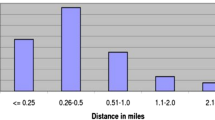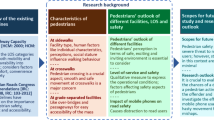Abstract
Pedestrian safety has become a significant problem in today’s world, and pedestrian casualties have escalated in develo** countries where there are no special provisions for the movement of such vulnerable road users. The interaction between pedestrians and vehicles must be prioritised and requires extended study. Therefore, surrogate safety measures (SSMs) come in handy to find the relative spatial and temporal measures of road users under conflict. This study’s primary objective is to identify evasive action-based pedestrian safety indicators that are best suited for predicting pedestrian behaviour under mixed traffic conditions. The pedestrian’s step frequency and lateral deviation are proven useful in measuring evasive actions based on the pedestrian’s trajectory data. Furthermore, an expert-based analysis is undertaken to evaluate which evasive action-based parameters are most appropriate in identifying the severity of pedestrian safety. Hence, it was found that the lateral deviation has a more significant potential influence on severity identification than step frequency.
Access this chapter
Tax calculation will be finalised at checkout
Purchases are for personal use only
Similar content being viewed by others
References
Organization WH (2018) Global status report on road safety 2018: summary. World Health Organization
MoRTH (2017) Road accidents in India. Transportation research wing. Ministry of road transport and highways, Government of India
Lu L, Ren G, Wang W, Chan CY, Wang J (2016) A cellular automaton simulation model for pedestrian and vehicle interaction behaviors at unsignalized mid-block crosswalks. Accid Anal Prev 95:425–437
Parker Jr, MR, Zegeer CV (1989) Traffic conflict techniques for safety and operations: Observers manual. No. FHWA-IP-88-027, NCP 3A9C0093. United States. Federal Highway Administration
Schroeder B, Rouphail N, Salamati K, Hunter E, Phillips B, Elefteriadou L, Mamidipalli S (2014) Empirically-based performance assessment and simulation of pedestrian behavior at unsignalized crossings. Southeastern Transportation Research, Innovation, Development and Education Center
Fu T, Miranda-Moreno L, Saunier N (2018) A novel framework to evaluate pedestrian safety at non-signalized locations. Accid Anal Prev 111:23–33
Goh BH, Subramaniam K, Wai YT, Mohamed AA, Ali A (2012) Pedestrian crossing speed: the case of Malaysia. Int J Traffic Transp Eng 2(4):323–332
Knoblauch RL, Pietrucha MT, Nitzburg M (1996) Field studies of pedestrian walking speed and start-up time. Transp Res Rec 1538(1):27–38
Malkhamah S, Tight M, Montgomery F (2005) The development of an automatic method of safety monitoring at Pelican crossings. Accid Anal Prev 37(5):938–946
Tageldin A, Sayed T, Shaaban K (2017) Comparison of time-proximity and evasive action conflict measures: case studies from five cities. Transp Res Rec 2661(1):19–29
Medina J, Benekohal R, Wang M-H (2008) In-street pedestrian crossing signs and effects on pedestrian–vehicle conflicts at University Campus Crosswalks. Transportation Research Board Annual Meeting, Washington, DC
Hediyeh H, Sayed T, Zaki MH, Ismail K (2014) Automated analysis of pedestrian crossing speed behavior at scramble-phase signalized intersections using computer vision techniques. Int J Sustain Transp 8(5):382–397
Zaki MH, Sayed T (2014) Automated analysis of pedestrians’ nonconforming behavior and data collection at an urban crossing. Transp Res Rec 2443(1):123–133
Hediyeh H, Sayed T, Zaki MH, Mori G (2014) Pedestrian gait analysis using automated computer vision techniques. Transp A: Transp Sci 10(3):214–232
Kathuria A, Vedagiri P (2020) Evaluating pedestrian vehicle interaction dynamics at un-signalized intersections: a proactive approach for safety analysis. Accid Anal Prev 134:105316
Sayed T, Zein S (1999) Traffic conflict standards for intersections. Transp Plan Technol 22(4):309–323
Fleiss JL (1971) Measuring nominal scale agreement among many raters. Psychol Bull 76(5):378
Author information
Authors and Affiliations
Corresponding author
Editor information
Editors and Affiliations
Rights and permissions
Copyright information
© 2024 The Author(s), under exclusive license to Springer Nature Singapore Pte Ltd.
About this paper
Cite this paper
Lyngdoh, G.K., Bhardwaj, A., Dutta, M., Jena, S. (2024). Examining the Evasive Behaviour of Pedestrians to Measure Their Degree of Vulnerabilities at Unsignalised Intersections. In: Singh, D., Maji, A., Karmarkar, O., Gupta, M., Velaga, N.R., Debbarma, S. (eds) Transportation Research. TPMDC 2022. Lecture Notes in Civil Engineering, vol 434. Springer, Singapore. https://doi.org/10.1007/978-981-99-6090-3_52
Download citation
DOI: https://doi.org/10.1007/978-981-99-6090-3_52
Published:
Publisher Name: Springer, Singapore
Print ISBN: 978-981-99-6089-7
Online ISBN: 978-981-99-6090-3
eBook Packages: EngineeringEngineering (R0)




